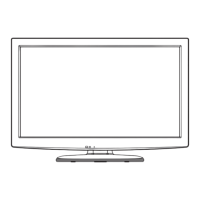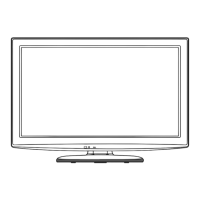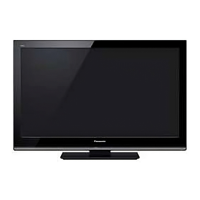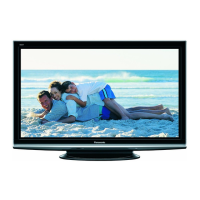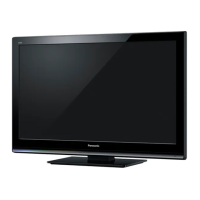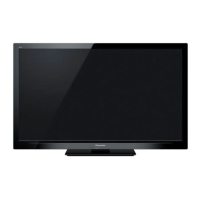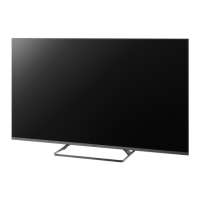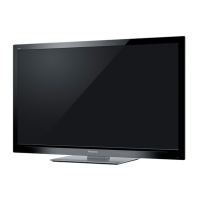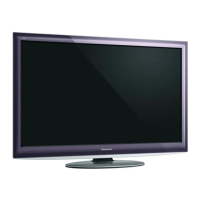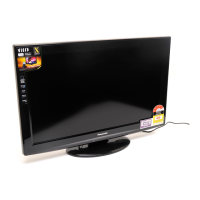
Do you have a question about the Panasonic Viera TH-L32X20A and is the answer not in the manual?
| Screen Size | 32 inches |
|---|---|
| Resolution | 1366 x 768 pixels |
| Display Type | LCD |
| HDMI Ports | 3 |
| USB Ports | 1 |
| HD Technology | HD Ready |
| Aspect Ratio | 16:9 |
| Dynamic Contrast Ratio | 50, 000:1 |
| Viewing Angle | 178° |
| Response Time | 6.5 ms |
Steps for safely inserting and removing batteries from the TV remote control.
Critical instructions for safe use of the power cord and plug to prevent electrical hazards.
Guidelines for safe power connection, indoor use, and TV placement.
Warning against accessing internal TV components due to high-voltage risks.
Precautions to prevent damage and shock from moisture and excessive heat.
Warnings against inserting objects into vents and placing the TV on unstable surfaces.
Requirement to use only approved pedestals or mounting equipment for stability.
Caution regarding small objects like SD cards being a choking hazard for children.
Guidance on ensuring the TV is placed securely on a stable surface to prevent tipping.
Instructions for safe TV cleaning and unplugging when not in use.
Importance of adequate space for heat dissipation and avoiding blocked air vents.
Advice on avoiding panel damage and excessive headphone volume.
Explanation of standby function and keeping TV away from certain electronic equipment.
Instructions on how to adjust the TV panel's swivel angle for optimal viewing.
Step-by-step guide for securely attaching the TV pedestal assembly.
Recommendations and methods for securing the TV to furniture to prevent accidents.
Information on purchasing and installing a recommended wall-hanging bracket.
Guide on connecting the TV's aerial input for receiving broadcast signals.
Detailed explanation of the functions of each button on the remote control.
How to navigate and use the TV's on-screen menu and display system.
Instructions on how to use the remote control with the on-screen menus.
How to turn on the TV and select between Digital or Analogue TV modes.
Different ways to select TV channels, including direct entry and channel lists.
Overview of additional functions like freezing pictures and setting the sleep timer.
How to view program information, ratings, and other details on the screen.
How to check and change current programme status like audio selection.
Options for adjusting the picture aspect ratio for optimal viewing.
Setting the correct region and time, including daylight saving adjustments.
Explanation of teletext services, FASTEXT, TOP, and List modes.
Using multi-window views and storing frequently viewed teletext pages.
Viewing specific sub-pages and watching TV while teletext updates.
How to access and select input sources for external devices.
Guidelines for connecting and viewing content from PCs and AV devices.
Using the TV remote to control connected VCRs, DVD players, etc.
Procedure for changing remote control codes for different external equipment.
Steps to display the main menu, select sub-menus, and choose items.
How to adjust settings, choose alternatives, and reset options.
Overview of picture-related settings available in the main menu.
Overview of sound-related settings available in the main menu.
Overview of system and setup options available in the main menu.
Detailed explanation of viewing modes and how to adjust picture parameters.
Settings for Eco Mode, Noise Reduction (P-NR), 3D-COMB, and Panel.
Explanation of sound modes (Music, Speech, User) and equalizer settings.
Settings for headphone volume, surround effects, and digital audio output.
Settings related to HDMI inputs and PC connection parameters.
Options for channel lists, auto tuning, manual tuning, and channel messages.
Settings for input labels, banner display timeout, and teletext mode.
Configuration for VIERA Link functions, power saving, and intelligent standby.
Options for shipping condition, system updates, and regional time settings.
Initial steps to select TV mode and access the setup menu for tuning.
How to access Digital TV or Analogue TV tuning menus.
Creating and managing favourite channel lists for quick access.
Skipping unwanted channels, revealing/hiding, and editing channel information.
Automatic search and storage of all available digital TV channels.
Manually tuning channels and updating the channel list.
Checking the quality and strength of the digital TV signal.
Managing analogue channels, including skipping and editing.
Performing automatic or manual tuning for analogue TV channels.
Accessing and viewing photos, videos, and music from an SD card.
Adjusting audio output settings and selecting SPDIF output format.
Configuring video playback settings like preview and repeat.
Introduction to VIERA Link and HDAVI Control for device interoperability.
Features like automatic input switching and channel download via VIERA Link.
Configuration of power-on/off links, standby power saving, and intelligent standby.
How to pause and resume live TV programmes using VIERA Link.
Recording the current programme directly to a connected DIGA recorder.
Controlling connected equipment menus and functions using the TV remote.
Diagrams illustrating how to connect various external devices to the TV.
Details on analogue channel allocation and digital TV rating systems.
How to select stereo, mono, or bilingual sound modes for broadcasts.
Information on HDMI features, audio/video signals, and compatibility.
How to connect equipment with a DVI output using an adapter.
Guidelines for connecting a PC to the TV for display and sound.
Important safety and usage instructions for handling SD cards.
Details on supported photo, video, and music file formats for SD cards.
Instructions for cleaning the display panel, cabinet, and mains plug.
Solutions for common problems like picture noise, no image, or remote issues.
Solutions for screen problems (noise, no image) and sound issues.
Troubleshooting steps for HDMI connection problems and digital TV reception.
Diagnosing and resolving issues with digital TV picture pixelation and signal loss.
Solutions for standby mode activation and intermittent remote control operation.
